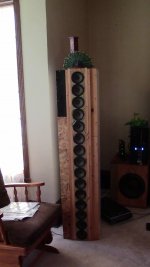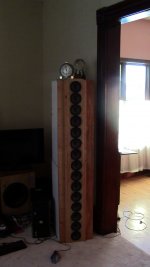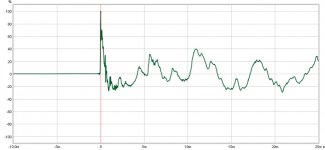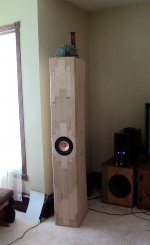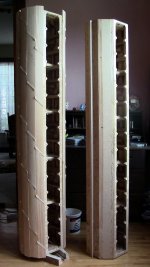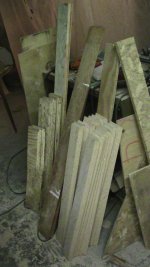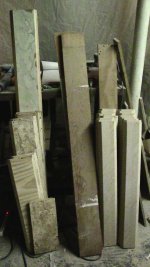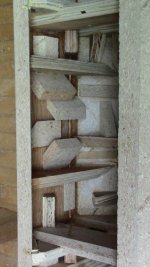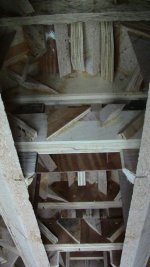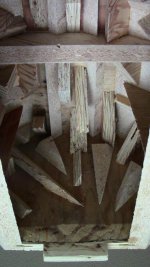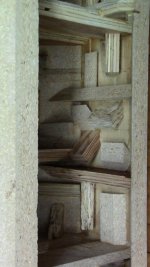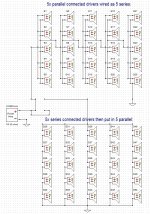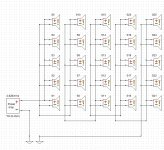What would you use to view a frequency dependent window? I'd highly recommend using DRC-FIR, as the frequency dependent window in REW is a lot more smoothed, and DRC tries to correct towards minimum phase behavior. It will also determine what not to correct for.
You don't want to correct a 500ms window or even a fixed gated one.
You don't want to correct a 500ms window or even a fixed gated one.
Time to hit "the books"...
I have not dug that deep yet. 😱 Yet, I would like to. I have only scratched the top of the surface on what high quality DSP processing can do. (DSP of the 1990's took me off the path for awhile.) I am already impressed with what I am able to accomplish with the basic software I use now, in terms of EQ, cross-over phase correction and time alignment with subs. You have inspired me to look into both DRC and REW, which definitely do more then rephase and HOLMImpulse. DRC definitely has better documentation. I am curious to see how the TRA feature in REW compares to TrueTRA, considering TrueTRA costs a lot of money to get the more detailed analyzer. (Thankfully, I have not purchased that feature).
With my current correction method, I have found that I get better results when I correct the frequency response of the speakers one meter away, on-axis. I have found also that EQing to the sine sweep in HOLM works better then leveling off pink noise in a TRA analyzer. This tells me, I need to pay attention more to the time domain, as in: "You don't want to correct a 500ms window or even a fixed gated one." - because I am sure I have! 😱
There is a lot of documentation with both DRC and REW. Let's see what I can learn! 😀
P.S. got the Placid Bipolar HD board together last night.
I have not dug that deep yet. 😱 Yet, I would like to. I have only scratched the top of the surface on what high quality DSP processing can do. (DSP of the 1990's took me off the path for awhile.) I am already impressed with what I am able to accomplish with the basic software I use now, in terms of EQ, cross-over phase correction and time alignment with subs. You have inspired me to look into both DRC and REW, which definitely do more then rephase and HOLMImpulse. DRC definitely has better documentation. I am curious to see how the TRA feature in REW compares to TrueTRA, considering TrueTRA costs a lot of money to get the more detailed analyzer. (Thankfully, I have not purchased that feature).
With my current correction method, I have found that I get better results when I correct the frequency response of the speakers one meter away, on-axis. I have found also that EQing to the sine sweep in HOLM works better then leveling off pink noise in a TRA analyzer. This tells me, I need to pay attention more to the time domain, as in: "You don't want to correct a 500ms window or even a fixed gated one." - because I am sure I have! 😱
There is a lot of documentation with both DRC and REW. Let's see what I can learn! 😀
P.S. got the Placid Bipolar HD board together last night.

Correcting Bass...
I should add, that I do not use the same mic position I mentioned above to correct my bass. Instead, I do indeed correct that at the listening seat, as bass is so room dependent.
It is going to be interesting to hear what I learn when I starting digging into the measuring aspects of time (CSD waterfalls). I would really like to see this mid-range issue I have show up on something. It really is a very small flaw - the splinter metaphor I mentioned a couple of posts ago is not too far off.
It really is a very small flaw - the splinter metaphor I mentioned a couple of posts ago is not too far off.
Either way, I am off now to read about REW, excited to try out some waterfalls...🙂
I should add, that I do not use the same mic position I mentioned above to correct my bass. Instead, I do indeed correct that at the listening seat, as bass is so room dependent.
It is going to be interesting to hear what I learn when I starting digging into the measuring aspects of time (CSD waterfalls). I would really like to see this mid-range issue I have show up on something.
 It really is a very small flaw - the splinter metaphor I mentioned a couple of posts ago is not too far off.
It really is a very small flaw - the splinter metaphor I mentioned a couple of posts ago is not too far off. Either way, I am off now to read about REW, excited to try out some waterfalls...🙂
Thanks for coming along for the ride, zman01! Almost missed your post. 😱
Not sure what I am going to be doing with that yet. Lots of reflecting to do. This project may play a part also... 😉
Good luck with the business side of things.
Not sure what I am going to be doing with that yet. Lots of reflecting to do. This project may play a part also... 😉
Way to welcome me back reply box! - lost everything... augh again
I haven't written on this thread for over a year, and just did an hour of writing and lost it all. Hitting the wrong button is a bad thing, so from now on, I am copy pasting from Notepad. I am only putting this here because I know others of You get passionate about writing and when this happens, there is no way to reverse it. I know there are software options available, but You have to have them set up on your system before head. So Notepad is just as easy for me.
Hitting the wrong button is a bad thing, so from now on, I am copy pasting from Notepad. I am only putting this here because I know others of You get passionate about writing and when this happens, there is no way to reverse it. I know there are software options available, but You have to have them set up on your system before head. So Notepad is just as easy for me.
I haven't written on this thread for over a year, and just did an hour of writing and lost it all.
 Hitting the wrong button is a bad thing, so from now on, I am copy pasting from Notepad. I am only putting this here because I know others of You get passionate about writing and when this happens, there is no way to reverse it. I know there are software options available, but You have to have them set up on your system before head. So Notepad is just as easy for me.
Hitting the wrong button is a bad thing, so from now on, I am copy pasting from Notepad. I am only putting this here because I know others of You get passionate about writing and when this happens, there is no way to reverse it. I know there are software options available, but You have to have them set up on your system before head. So Notepad is just as easy for me.A proper welcome!
Right'o so here we go again. Will this be what I wrote before? More then likely not. Hopefully, I can re-capture the moment and have it turn out better. 🙂
It has been a long time, hasn't it? 😱 I really wish I had more time to write on these forums, but alas, my time issues and work life balance have not improved. In fact, I have really been trying to work on it. I have been taking leadership classes, profiling my personality and searching for better options. Two promotions I went for have been eliminated altogether but there is hope for one in October if they do not eliminate that one also. As I live in a rural area, options are limited anyway. Yet I do have hope that I can get back into the Arts in my own business. But that is not something that can be built over-night, esp where I live. It is possible thou, and who knows, it may even turn out to be less work then the two jobs and the small business I run right now. I talked to other Artists about this and they said it is hard work, like anything else, but many admit that it was not as hard as they really thought. 😉
I really do not mind hard work, or even long hours, but I am getting pretty bored with what I am doing now. And based on all the self realization I have done lately, it is normal for me to be bored in the kind of jobs I have. It really does not align too well with the gifts I have. 😛 I do not mind my landscaping business as I enjoy helping my clients and being outside working with nature.
Anyway, I looked over the last couple of posts, and I realized that I have not even mentioned on my very own thread that I am rebuilding my cheap and cheerfuls arrays. 😱
I started the re-design in January 2017 and I have been diligently working on them since then, between all that other stuff i mentioned above - (believe me, there is a lot more woes I will not be sharing at this time). I really did not plan to take this re-do to the level I am, but You could say I am creating a cotton purse from a sow's ear. I say "cotton" because I am still using the 99 cent driver, workable, but not state of the art wood, and not the full floor to ceiling array I really aspire build. But having enjoyed these speakers so much in their ugly form, I figured they are worthy of a nice cabinet. Also, I am curious to see what a well executed build would offer to the table. This could only help future builds right? And to be honest with myself, I can already see it now, if I would have moved on to another build, these would more then likely never be finished in a nice cabinet. The new build would have confirmed my preconceived notion that the cheap drivers could only go so far. But, from the listening comparison between the different drivers I am considering for arrays (post 276), the 99 cent driver is in the ball park, not my favorite, but not undesirable either. So how much potential I am missing out on due to the crappy cabinets. We will see...
Here is the photos of what they were:
Right'o so here we go again. Will this be what I wrote before? More then likely not. Hopefully, I can re-capture the moment and have it turn out better. 🙂
It has been a long time, hasn't it? 😱 I really wish I had more time to write on these forums, but alas, my time issues and work life balance have not improved. In fact, I have really been trying to work on it. I have been taking leadership classes, profiling my personality and searching for better options. Two promotions I went for have been eliminated altogether but there is hope for one in October if they do not eliminate that one also. As I live in a rural area, options are limited anyway. Yet I do have hope that I can get back into the Arts in my own business. But that is not something that can be built over-night, esp where I live. It is possible thou, and who knows, it may even turn out to be less work then the two jobs and the small business I run right now. I talked to other Artists about this and they said it is hard work, like anything else, but many admit that it was not as hard as they really thought. 😉
I really do not mind hard work, or even long hours, but I am getting pretty bored with what I am doing now. And based on all the self realization I have done lately, it is normal for me to be bored in the kind of jobs I have. It really does not align too well with the gifts I have. 😛 I do not mind my landscaping business as I enjoy helping my clients and being outside working with nature.
Anyway, I looked over the last couple of posts, and I realized that I have not even mentioned on my very own thread that I am rebuilding my cheap and cheerfuls arrays. 😱
I started the re-design in January 2017 and I have been diligently working on them since then, between all that other stuff i mentioned above - (believe me, there is a lot more woes I will not be sharing at this time). I really did not plan to take this re-do to the level I am, but You could say I am creating a cotton purse from a sow's ear. I say "cotton" because I am still using the 99 cent driver, workable, but not state of the art wood, and not the full floor to ceiling array I really aspire build. But having enjoyed these speakers so much in their ugly form, I figured they are worthy of a nice cabinet. Also, I am curious to see what a well executed build would offer to the table. This could only help future builds right? And to be honest with myself, I can already see it now, if I would have moved on to another build, these would more then likely never be finished in a nice cabinet. The new build would have confirmed my preconceived notion that the cheap drivers could only go so far. But, from the listening comparison between the different drivers I am considering for arrays (post 276), the 99 cent driver is in the ball park, not my favorite, but not undesirable either. So how much potential I am missing out on due to the crappy cabinets. We will see...
Here is the photos of what they were:
Attachments
Last edited:
Measurement Inspiration
Here is one of the objective reasons that inspired me to remake these arrays.
Wesayso always mentioned the importance to the first 20 ms in the impulse response, but I never knew exactly how to find it. Once he guiding me to the images and proper settings, I found some interesting surprises.
I listen to my Arrays and Avebury systems in the same locations. When comparing the 20 ms STEP responses at the listening seat, You will notice that the arrays have a lot more spikes in the first 5 ms then the Avebury does. We thought this could be elements of the corners by the speakers, and some could indeed be so, but my gut figured a lot was coming from the cabinets and the driver protruding rims. We will see how reliable my gut really is. 🙂
I included photos of my Avebury locations for the objective types out there.
Here is one of the objective reasons that inspired me to remake these arrays.
Wesayso always mentioned the importance to the first 20 ms in the impulse response, but I never knew exactly how to find it. Once he guiding me to the images and proper settings, I found some interesting surprises.
I listen to my Arrays and Avebury systems in the same locations. When comparing the 20 ms STEP responses at the listening seat, You will notice that the arrays have a lot more spikes in the first 5 ms then the Avebury does. We thought this could be elements of the corners by the speakers, and some could indeed be so, but my gut figured a lot was coming from the cabinets and the driver protruding rims. We will see how reliable my gut really is. 🙂
I included photos of my Avebury locations for the objective types out there.
Attachments
Introducing the Cheerful Conglomerates
As You can see from the photos, I ended reusing the wood from the prototype design. It is what is going to make the differences so interesting. What can one really do if on a budget. Do not worry, I have many builds planned with better materials, some that I already have. But, for many people, times are tough. How far can we go with limited funds? Also, this is a creative hazard I have, I like to recycle things, and make them useful. 😀 Even if I end up with two sets of "better" arrays in my main listening room. I would enjoy these in my studio.
The right cabinet in the photo shows the conglomerated core structure of plywood, particle board and some OSB (I really wished I would have spent the $20 on A/C plywood thou 😱). There are consequences I found using so many different woods, and I should have known better - but the creativity over ran my logic. I am more Artist then Engineer, and I am totally okay with that. But as I said earlier, I really did not plan for this build to become the art it has. I was planning on a glue and screw build, but after taking the prototypes apart and seeing what the screws did to the wood, that was out. (more on that later).
The Left cabinet shows the fir door trim mosaic I created to make the cabinets circular columns. I always wanted to try a column design, even if the beveled sided rectangle is as practical.
Both cabinets have the fir door trim mosaics on them now...
As You can see from the photos, I ended reusing the wood from the prototype design. It is what is going to make the differences so interesting. What can one really do if on a budget. Do not worry, I have many builds planned with better materials, some that I already have. But, for many people, times are tough. How far can we go with limited funds? Also, this is a creative hazard I have, I like to recycle things, and make them useful. 😀 Even if I end up with two sets of "better" arrays in my main listening room. I would enjoy these in my studio.
The right cabinet in the photo shows the conglomerated core structure of plywood, particle board and some OSB (I really wished I would have spent the $20 on A/C plywood thou 😱). There are consequences I found using so many different woods, and I should have known better - but the creativity over ran my logic. I am more Artist then Engineer, and I am totally okay with that. But as I said earlier, I really did not plan for this build to become the art it has. I was planning on a glue and screw build, but after taking the prototypes apart and seeing what the screws did to the wood, that was out. (more on that later).
The Left cabinet shows the fir door trim mosaic I created to make the cabinets circular columns. I always wanted to try a column design, even if the beveled sided rectangle is as practical.
Both cabinets have the fir door trim mosaics on them now...
Attachments
Now back to the beginning...
Here is what my aspirations are for this project:
Goals:
Nicer looking cabinets
More solid build
Air tight build
Eliminate driver protrusion diffraction
Eliminate mid and high cabinet diffractions
See if this smooth cabinet diffraction theory holds any water and affects measurements and more importantly listening impressions.
Hopes:
Lower bass response, at least down to 40 Hz (prototypes went to 80 Hz)
Subjective "Grain" I hear in background is eliminated
More resolving overall - closer to what I like in my Avebury system (although I am not sure what that really is 🙂 )
More "air" in the highs - like Avebury (but I am thinking this is a pipe dream)
Better dispersion in the highs - not expecting miracles here, but thinking if cabinet and driver rim diffractions where existent that less of them would show some improvement in this area.
Speakers "disappear" during playback - prototypes did not do that, due to something with the highs. Wesayso reported that his arrays do "disappear", so if his can, there has to be a way these can too. 🙂
So here we are, over a year later, and still wondering...
Here are the photos after cutting the prototypes up into their new parts. 🙂
Even then, I had no idea what these are to become...
Right'o, checking off for tonight, big, long work week on the way 🙁
Hopefully, I will not be away for a year again...
Here is what my aspirations are for this project:
Goals:
Nicer looking cabinets
More solid build
Air tight build
Eliminate driver protrusion diffraction
Eliminate mid and high cabinet diffractions
See if this smooth cabinet diffraction theory holds any water and affects measurements and more importantly listening impressions.
Hopes:
Lower bass response, at least down to 40 Hz (prototypes went to 80 Hz)
Subjective "Grain" I hear in background is eliminated
More resolving overall - closer to what I like in my Avebury system (although I am not sure what that really is 🙂 )
More "air" in the highs - like Avebury (but I am thinking this is a pipe dream)
Better dispersion in the highs - not expecting miracles here, but thinking if cabinet and driver rim diffractions where existent that less of them would show some improvement in this area.
Speakers "disappear" during playback - prototypes did not do that, due to something with the highs. Wesayso reported that his arrays do "disappear", so if his can, there has to be a way these can too. 🙂
So here we are, over a year later, and still wondering...
Here are the photos after cutting the prototypes up into their new parts. 🙂
Even then, I had no idea what these are to become...
Right'o, checking off for tonight, big, long work week on the way 🙁
Hopefully, I will not be away for a year again...
Attachments
Hi Allen,
Good to see you on diyAudio again, and also good to see you progressing on your journey. Keep us posted! 🙂
Good to see you on diyAudio again, and also good to see you progressing on your journey. Keep us posted! 🙂
Keep us posted! 🙂
I will do my best, Zman! I can get thru Mondays relatively well, but as the repetition of the work week continues, my mind goes
 in a not so enlightened way...
in a not so enlightened way...  Maybe posting on here will help.
Maybe posting on here will help. 
What projects have You been working on lately? You are welcome to leave a link if You desire. 🙂
Jump ahead to the insides
Thanks, Ronald:
For laughs and giggles - what do You think of the insides?
I really got into this, no plan what so ever, just pure fun!
What I can say, this made a big difference when I would talk into the cabinets. This really cut down the reverb inside the box, esp with the middle and high part of my voice. It did not cut my low ranges too much though, but I am satisfied what this burst of fun accomplished. I really wished I would have recorded a sound clip of before and after thou. Hopefully I will remember on the next build...
I really like where this is going!
Thanks, Ronald:
For laughs and giggles - what do You think of the insides?
I really got into this, no plan what so ever, just pure fun!
What I can say, this made a big difference when I would talk into the cabinets. This really cut down the reverb inside the box, esp with the middle and high part of my voice. It did not cut my low ranges too much though, but I am satisfied what this burst of fun accomplished. I really wished I would have recorded a sound clip of before and after thou. Hopefully I will remember on the next build...
Attachments
Last edited:
I really got into this, no plan what so ever, just pure fun!
Actually, I need to clarify the "no plan what so ever". What I mean by that is that I did not have this diffusion figured out in the beginning. I knew I wanted diffusion. I knew I wanted bracing that would break the panels up into as different as possible dimensions to spread out any resonances I had. But I had no concrete plan. Instead, I figured it out as I went along and in a lot of cases by looking at the potential in the cut offs and other pieces of wood that would normally be considered scraps. 🙂
It will make a lot more sense as I progress with the documentation of the build...
...Had to be sure I was not accidentally mis-representing my build. 😉
What projects have You been working on lately? You are welcome to leave a link if You desire. 🙂
Been building a Class A single ended amplifier, progress has been slower than expected 🙂 :
http://www.diyaudio.com/forums/soli...id-aleph-alpha-amplifier-200.html#post5418375
Been building a Class A single ended amplifier, progress has been slower than expected 🙂 :
http://www.diyaudio.com/forums/soli...id-aleph-alpha-amplifier-200.html#post5418375
Zman,
You are actually making great progress - you will probably be builder number 5 to get it working so not too bad. You will get there soon!
ArtsyAllen,
Here is the big boy version of the Alpha, a 52w air cooled gentle giant:
The sound is perhaps the best amplifier I have heard. Pure SE Class A and drives speakers with authority but with characteristic SE Class sound and low THD.
Thanks, Ronald:
For laughs and giggles - what do You think of the insides?
I really got into this, no plan what so ever, just pure fun!
What I can say, this made a big difference when I would talk into the cabinets. This really cut down the reverb inside the box, esp with the middle and high part of my voice. It did not cut my low ranges too much though, but I am satisfied what this burst of fun accomplished. I really wished I would have recorded a sound clip of before and after thou. Hopefully I will remember on the next build...
😱 You have been busy! I like that it's pretty random. It remains debatable if it really scatters and diffracts inside waves (due to the size compared to wave lengths) but it does a good job of making wall shapes random and brakes up parallel planes. Don't forget to put in plenty of damping material, fiberglass isolation being one of the best broad band attenuators. Leave some breathing room behind the driver.
Also look at the impedance of the drivers in the enclosure to look for wiggles that shouldn't be there. Be sure to test a single driver's impedance in free air to see what that looks like.
Look at the thread from fluid for the best wiring scheme to use. The discussion started about here but the fun starts a little later. Further simulation showed some interesting differences between:
5 drivers in series connection, 5 groups of those in parallel and
5 drivers in parallel connection, 5 groups of those in series.
From those simulations it shows the 5 parallel drivers, hooked up in 5 identical series are more equally loaded. Both in terms of displacement and watts received. I know of one array here that's wired like that, the one from OPC. When fluid wired his and it showed similar behaviour to mine (a strange dip at the impedance peak) we started investigating it with the above linked results. OPC showed his clean looking impedance curves in that thread. Each dip or wiggle could lead to dips or peaks in the frequency response.
It's just a little more work but I think it's worth it if you start from scratch.
The wiring diagram BYRTT drew up in XSim for this test:
Top diagram in the above (each driver has it's own measured impedance curve loaded into XSim for these simulations).
Can easily be changed to:
That way its pretty easy to wire it all up in parallel - series without using much more wire. Start with a positive lead for the first 5 drivers. The negative wire for the first 5 drivers is the positive lead for the next group of 5 and so on. Hardly any more wire needed when compared to series parallel wiring.
If I ever find the time I'll rewire my own arrays, if for nothing else than pure curiosity. Mine are still wired as series - parallel at the moment.
Attachments
Last edited:
First One still going stong
I feel You on that one! The passion to move ahead can get down right painful at times, but I think there is greatness in the suffering of our journeys that is truly inspirational for us all. Our world seriously needs more of that.
Our world seriously needs more of that.
Wow, You have peeked some curiosity! I have always wondered what SE brings to the table. Is the gray modu chassis behind the amp modules a part of the design? I see trannys with the modules, so I am thinking those are the PSUs?
While to the topic of amps:
I am still very happy with my First One. And just for the record, the only problem I have had with it, is the left channel will switch off when I run them at max volume with blu-ray content below 20 Hz. We are talking 10 Hz stuff here. Basically, it kicks in the DC protection circuit. As that side runs a little hotter then the right side, I am thinking I need to re-adjust it a bit. As my Avebury does not do the 10 hz stuff too well, I cut it out in DSP 🙂 At least I know the protection is doing its job, so this is a good thing. I am only mentioning this, because I have saw on the First One thread that other well respected DIYaudio members have had issues with these modules, and it has discouraged me a bit, as I would like some more investigation taking place on why these things have happened. This is why I built this amp with all the recommended parts, because I am nowhere near knowledgeable enough to be creative with electronics. Having said all of this, this is still a great amp, I hope it lasts. If something was to happen - God forbid - I would send the module back to Lazy Cat for investigation and buy a replacement module, as I do still love it very much. 🙂
And just for the record, the only problem I have had with it, is the left channel will switch off when I run them at max volume with blu-ray content below 20 Hz. We are talking 10 Hz stuff here. Basically, it kicks in the DC protection circuit. As that side runs a little hotter then the right side, I am thinking I need to re-adjust it a bit. As my Avebury does not do the 10 hz stuff too well, I cut it out in DSP 🙂 At least I know the protection is doing its job, so this is a good thing. I am only mentioning this, because I have saw on the First One thread that other well respected DIYaudio members have had issues with these modules, and it has discouraged me a bit, as I would like some more investigation taking place on why these things have happened. This is why I built this amp with all the recommended parts, because I am nowhere near knowledgeable enough to be creative with electronics. Having said all of this, this is still a great amp, I hope it lasts. If something was to happen - God forbid - I would send the module back to Lazy Cat for investigation and buy a replacement module, as I do still love it very much. 🙂
However, one day I would not mind trying other designs also - as there is always a need for more amps - this Alpha looks like a nice amp for a tweeter array. 😀 Been curious about that for a future project too. 😉
...progress has been slower than expected 🙂
I feel You on that one! The passion to move ahead can get down right painful at times, but I think there is greatness in the suffering of our journeys that is truly inspirational for us all.
 Our world seriously needs more of that.
Our world seriously needs more of that. Here is the big boy version of the Alpha, a 52w air cooled gentle giant
Wow, You have peeked some curiosity! I have always wondered what SE brings to the table. Is the gray modu chassis behind the amp modules a part of the design? I see trannys with the modules, so I am thinking those are the PSUs?
While to the topic of amps:
I am still very happy with my First One.
 And just for the record, the only problem I have had with it, is the left channel will switch off when I run them at max volume with blu-ray content below 20 Hz. We are talking 10 Hz stuff here. Basically, it kicks in the DC protection circuit. As that side runs a little hotter then the right side, I am thinking I need to re-adjust it a bit. As my Avebury does not do the 10 hz stuff too well, I cut it out in DSP 🙂 At least I know the protection is doing its job, so this is a good thing. I am only mentioning this, because I have saw on the First One thread that other well respected DIYaudio members have had issues with these modules, and it has discouraged me a bit, as I would like some more investigation taking place on why these things have happened. This is why I built this amp with all the recommended parts, because I am nowhere near knowledgeable enough to be creative with electronics. Having said all of this, this is still a great amp, I hope it lasts. If something was to happen - God forbid - I would send the module back to Lazy Cat for investigation and buy a replacement module, as I do still love it very much. 🙂
And just for the record, the only problem I have had with it, is the left channel will switch off when I run them at max volume with blu-ray content below 20 Hz. We are talking 10 Hz stuff here. Basically, it kicks in the DC protection circuit. As that side runs a little hotter then the right side, I am thinking I need to re-adjust it a bit. As my Avebury does not do the 10 hz stuff too well, I cut it out in DSP 🙂 At least I know the protection is doing its job, so this is a good thing. I am only mentioning this, because I have saw on the First One thread that other well respected DIYaudio members have had issues with these modules, and it has discouraged me a bit, as I would like some more investigation taking place on why these things have happened. This is why I built this amp with all the recommended parts, because I am nowhere near knowledgeable enough to be creative with electronics. Having said all of this, this is still a great amp, I hope it lasts. If something was to happen - God forbid - I would send the module back to Lazy Cat for investigation and buy a replacement module, as I do still love it very much. 🙂 However, one day I would not mind trying other designs also - as there is always a need for more amps - this Alpha looks like a nice amp for a tweeter array. 😀 Been curious about that for a future project too. 😉
- Status
- Not open for further replies.
- Home
- Loudspeakers
- Full Range
- All Aspiring Full-Range Array project
